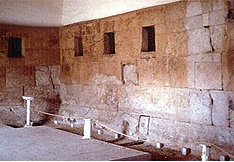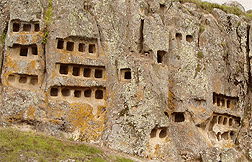|
|
 |
 |
|
|
Cajamarca's cultural tradition dates back to times before the Incas. Between 1000 B.C. and 200 B.C. the area belonged to a  northern cultural region which was home to important ceremonial centers and which remains allow us to appreciate today, among other things, the elaborate gold and silver jewelry accomplished by its people. Approximatly 900 A.C., the Caxamarca Culture came to life in this site, a civilization with a rich pottery tradition.
When Inca Cápac Yupanqui attached this territory to the Tahuantinsuyo, the kingdom of Cuismanco had prospered there, managing to foster cultural unity in the area: the Culle language had spread, as well as a series of divine beings, such as Catequil (lightning), Su (sun), Chuip (star), and Muñ (moon). On this basis, Cajamarca soon became an important Inca administration center, and throughout the empire, its weavers became famous for their excellence. northern cultural region which was home to important ceremonial centers and which remains allow us to appreciate today, among other things, the elaborate gold and silver jewelry accomplished by its people. Approximatly 900 A.C., the Caxamarca Culture came to life in this site, a civilization with a rich pottery tradition.
When Inca Cápac Yupanqui attached this territory to the Tahuantinsuyo, the kingdom of Cuismanco had prospered there, managing to foster cultural unity in the area: the Culle language had spread, as well as a series of divine beings, such as Catequil (lightning), Su (sun), Chuip (star), and Muñ (moon). On this basis, Cajamarca soon became an important Inca administration center, and throughout the empire, its weavers became famous for their excellence.
On November 15, 1532, Inca Atahualpa was taken prisoner by a group of Spaniards, to whom he offered one room full of gold and two rooms full  of silver as a ransom for his release. A few months later, the Inca was sentenced to die by garrote. This opened up a new chapter in the history of this territory, in which the Town of San Antonio de Cajamarca is consolidated, erected in the 16th century on the remains of the old Inca settlement. Agricultural and livestock raising activities then prospered, as did the production of textiles in the Colonial workshops, and a magnificent architecture was developed. Since 1772, Cajamarca became very important in the Colonial economy, since the Hualgayoc Mine was discovered, giving rise to the recovery of the mining industry, which was in poor shape. At present, showing its Colonial traces, Cajamarca maintains its farming, handcraft and mining tradition. of silver as a ransom for his release. A few months later, the Inca was sentenced to die by garrote. This opened up a new chapter in the history of this territory, in which the Town of San Antonio de Cajamarca is consolidated, erected in the 16th century on the remains of the old Inca settlement. Agricultural and livestock raising activities then prospered, as did the production of textiles in the Colonial workshops, and a magnificent architecture was developed. Since 1772, Cajamarca became very important in the Colonial economy, since the Hualgayoc Mine was discovered, giving rise to the recovery of the mining industry, which was in poor shape. At present, showing its Colonial traces, Cajamarca maintains its farming, handcraft and mining tradition.
|
|
|